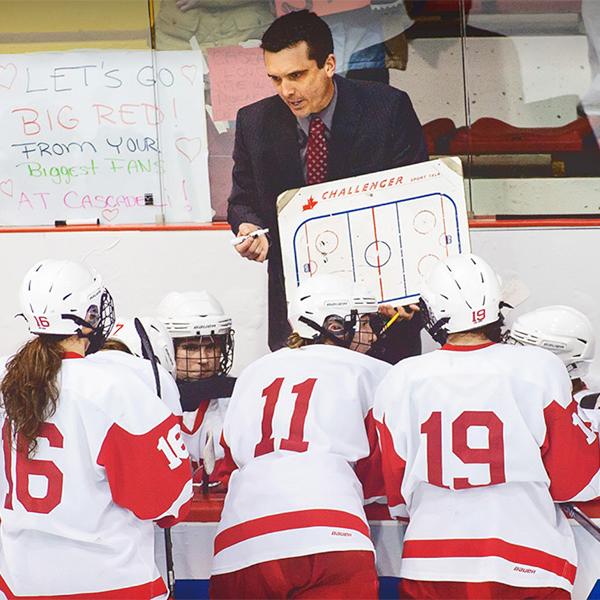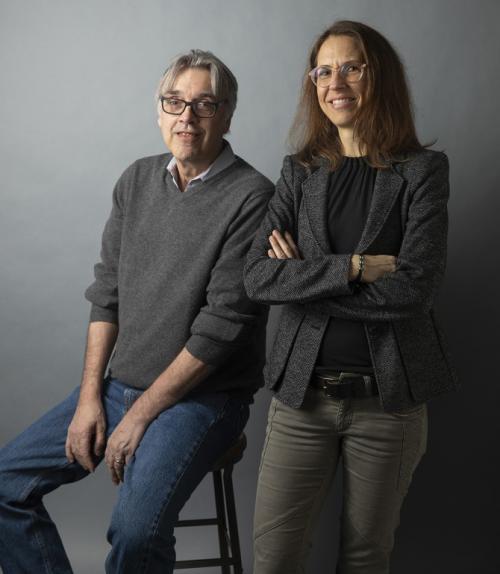Richard Cerione is the Goldwin Smith Professor of pharmacology and chemical biology in the Department of Molecular Medicine in the College of Veterinary Medicine and in the Department of Chemistry and Chemical Biology in the College of Arts and Sciences. Claudia Fischbach is a professor of biomedical engineering in the Nancy E. and Peter C. Meinig School of Biomedical Engineering and is co-director of the Cornell Physical Sciences Oncology Center on the Physics of Cancer Metabolism.
Together they study cancer biology. Cerione researches cancer cell metabolism, looking at the biological signaling cues and pathways that regulate cell growth, differentiation and development, and the protein-protein interactions underlying the metabolic changes required for cancer development; Fischbach uses tissue engineering, microfabrication and biomaterials strategies to study cancer cells’ interactions with other cells and the extracellular matrix and their importance to the development and progression of cancer.
Cerione and Fischbach are members of the provost’s Genome Biology Task Force,which Cerione co-chairs with professor of molecular biology and genetics John Lis.
How does your collaboration work, and how did it develop?
Fischbach: We started collaborating in 2013, on a project where my lab had previously found that tumor cells secrete factors that make cancers more aggressive by altering their microenvironment. … Rick’s lab had done research on specific types of vesicles shed by cancer cells that we hypothesized might have contributed to what we observed in our experiments.
We wrote a proposal that ultimately wasn’t funded but that built the foundation for a broader collaboration and a National Cancer Institute-funded proposal that became Cornell’s Physical Sciences Oncology Center on the Physics of Cancer Metabolism. This center is run between Ithaca and Weill Cornell Medicine, and is co-directed by Dr. Lewis Cantley, Ph.D. ’75, Meyer Director of the Sandra and Edward Meyer Cancer Center. Rick’s and my initial interactions became a collaboration between labs in multiple colleges and on different campuses at Cornell.
Rick is one of the leading cancer biologists in Ithaca, and we study cancer from very different perspectives – I’m applying engineering concepts and techniques, and he uses biochemical and chemical biology approaches – so merging our areas of expertise made sense.
Cerione: The center that Claudia co-directs is a really big part of fostering these sorts of collaborations. It was really a heroic effort for her to put the center together and get it funded, and it really provides the opportunity for lots of different collaborations, including with researchers and physicians at Weill Cornell Medicine. The whole goal was what Claudia was alluding to: what’s possible here at Cornell in terms of the physical sciences and engineering, and how you would bring those disciplines to bear on cancer.
So for someone like me, it’s really a unique advantage to be able to interact and collaborate with these types of investigators so that we can work together to approach fundamental problems in cancer biology.
Fischbach: Oftentimes, what happens with these large, multi-investigator proposals from federal funding agencies is, they provide the framework but rarely enough money to really bring everyone together to do significant work. So the university needs to be invested in supporting these initiatives, and that has happened in our case. The collective contributions of people, at different colleges and on different campuses, lead to more significant insights and advancements than what would be possible with a single lab.
What are your most recent or ongoing collaborative project(s)?
Fischbach: We are focusing on how the unique metabolic activities of cancer cells enable them to deal with nutrient stresses and oxygen deprivation in a manner very differently from normal cells. We are focusing on understanding the mechanisms responsible for these metabolic changes, as well as their functional consequences, and how we can use that information to target cancer cells therapeutically.
We are using the metabolism of cancer cells as a central anchor, an overarching framework, with the goal of gaining a broader appreciation of not only the metabolic activities of tumor cells, but how the microenvironment of tumor cells contributes to altering their metabolic programs – and vice versa. That is, how tumor cells alter the metabolism of surrounding noncancerous cells. One such example of these interplays is how obesity predisposes tumor cells to become more aggressive. What are the mechanisms that the tumor cells use to respond to that, and what is the back and forth?
Cerione: We’re trying to understand some of the mechanisms that the cancer cells use to communicate with their environment, and we’re looking at clues as to what makes a cancer cell more aggressive, more invasive, having greater metastatic potential.
Fischbach: This demonstrates the principle quite nicely: If you think of cancer as a seed, it needs the right soil, and so we’re studying what that soil is and how it affects the tumor. Traditionally, biologists have done a lot of studies in a petri dish, and that’s not the soil that tumor cells would see in the body. What we’re trying to do is actually mimic that environment, and then look at the back and forth between the two.
We’re also taking advantage of the fact that Ithaca has tremendous expertise in imaging, and so we’re collaborating with the imaging faculty and core facilities of the Biotechnology Resource Core, which is allowing us to do spatially and temporally resolved analyses in ways that wouldn’t be possible in just a regular lab.
Tell me a bit about the changes in the research culture on the Ithaca campus you’ve seen in recent years.
Cerione: In the past, I never thought of Cornell’s Ithaca campus particularly as a disease-oriented research university. I always thought of us as doing basic science, in the purest sense, whether it was on the physical side or even in biological areas, or in molecular biology and genetics. So I don’t think it came naturally to our university to think about approaching cancer research like a major medical center would. You need a mindset that says, “We’re going to be great in cancer research on this campus; how do we do it?”
Weill Cornell Medicine is an example. They’re putting a lot of emphasis into precision medicine because when they look at their strengths on the New York City campus, it’s in the translational research areas. Here in Ithaca, there is really great basic cancer biology research that comes both from the physical side and the biological side, so there is tremendous collaborative potential with Weill Cornell Medicine. It comes down to what’s possible here to complement what’s possible there, and vice versa.
This sort of complementation is not necessarily easy. It requires a cultural shift, and it is a challenge that stems from different disciplines and perspectives. You have medical schools and you have physicians, and they think about things one way, and the basic scientists think the other way, so there is always that kind of natural divide that needs to be bridged.
Things have changed here on the Ithaca campus on a cultural level. Just as examples: For years, we had no Howard Hughes Medical Institute investigators on this campus – they fund outstanding scientists who do biomedical research. We now have two. And for several years, we had only one Pew Scholar in the Biomedical Sciences. Now we have five.
Fischbach: There are also ongoing discussions to have joint graduate programs with Weill Cornell Medicine, where people are being sent back and forth. Some of our biomedical engineering Ph.D. students actually have advisers in the city and are spending most of their time with faculty there.
What recent technological advances in your fields have changed the potential impact of your research?
Fischbach: Being able to study tumor cells in model systems that mimic conditions inside the human body, for example, by culturing pieces of a patient’s tumor (so-called organoids) within three-dimensional microfluidic scaffolds or body-on-a-chip devices. In addition, linking these technologies with precision medicine or 3D printing offers additional opportunities. While it is clear that the molecular and cellular mechanisms of cancer are extremely complex, technologies are now available to dissect that complexity under conditions that mimic a specific patient scenario. Such approaches can also be used for more relevant drug testing.
Cerione: Imaging is another area that is just exploding; one specific area is optogenetics. Neurobiologists are now able to image changes in what’s going on in the neurons in an animal under different conditions. Another area that is exploding is cryo-electron microscopy; this has allowed for possibilities in obtaining the three-dimensional structures of large proteins and protein complexes that are truly revolutionary.
Through your collaborating, what is something that each of you has learned from the other?
Cerione: I’ve certainly learned the value of the sorts of systems Claudia developed. If you’re really going to try to understand metastasis, you need to be able to look at systems that more closely mimic what a microenvironment is, and what a tumor cell is really living in, versus a 2D cell culture in plastic.
Fischbach: Collaborations between engineers and cancer researchers and clinicians are mutually beneficial. While we have the tools and technologies to model certain scenarios, input from biologists and clinicians is critical to make sure we focus on the most pressing issues. Also, validating the relevance of engineered models with animal studies or clinical specimens is key to ensure translational impact. Being able to collaborate with people like Rick and Lew has been tremendously helpful for us.





